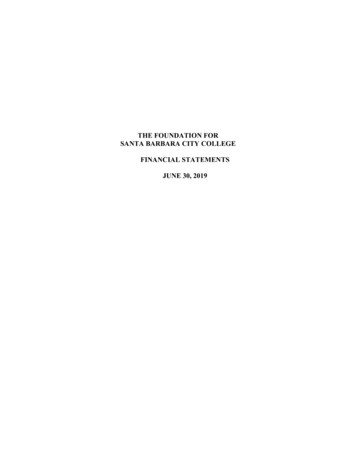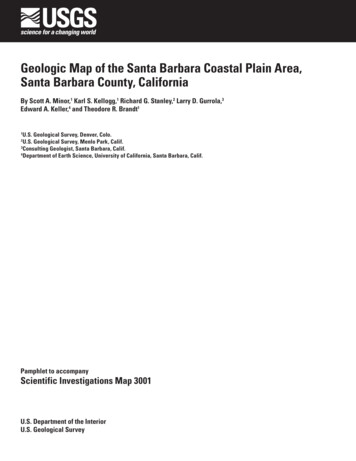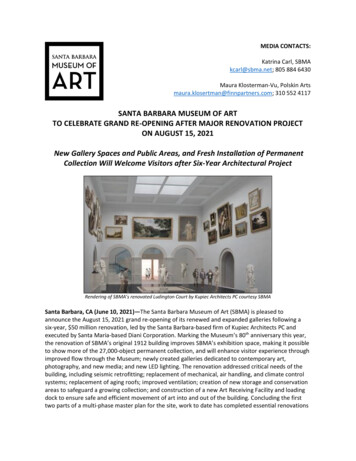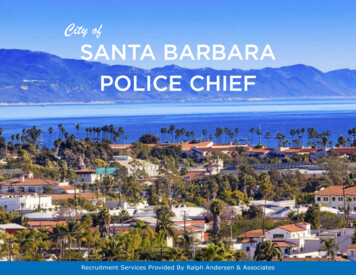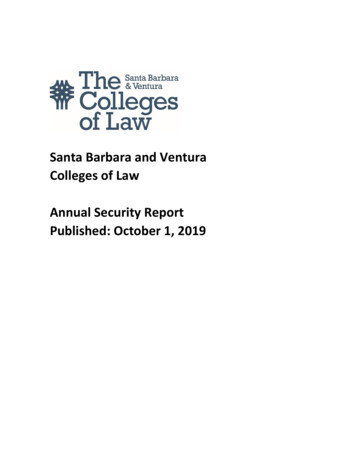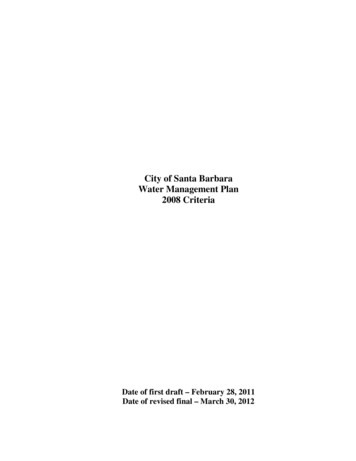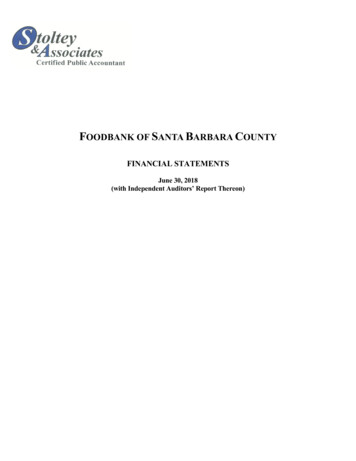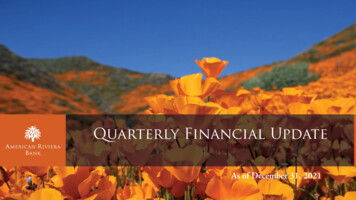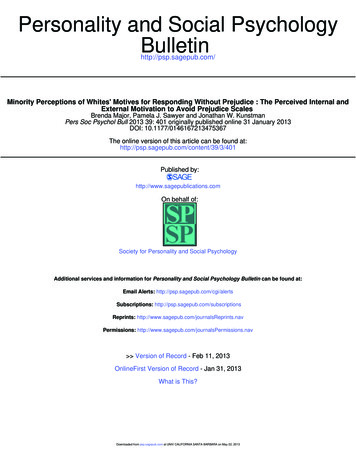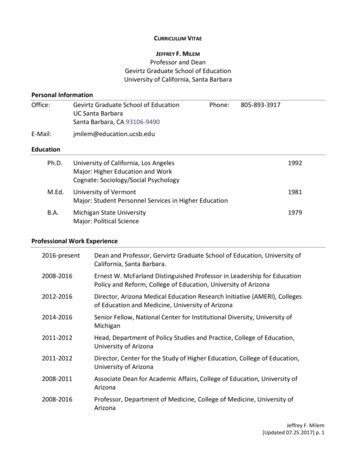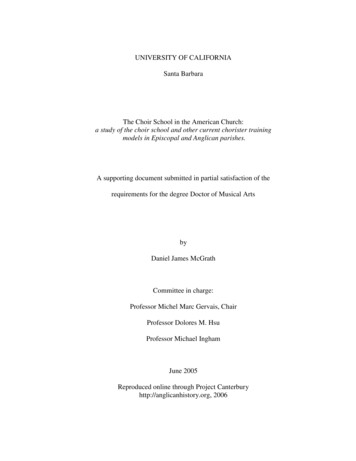
Transcription
UNIVERSITY OF CALIFORNIASanta BarbaraThe Choir School in the American Church:a study of the choir school and other current chorister trainingmodels in Episcopal and Anglican parishes.A supporting document submitted in partial satisfaction of therequirements for the degree Doctor of Musical ArtsbyDaniel James McGrathCommittee in charge:Professor Michel Marc Gervais, ChairProfessor Dolores M. HsuProfessor Michael InghamJune 2005Reproduced online through Project Canterburyhttp://anglicanhistory.org, 2006
The document of Daniel James McGrath is approved.Professor Michel Marc GervaisProfessor Dolores M. HsuProfessor Michael Ingham
To Josephine and Danny1
The Choir School in the American ChurchCopyright 2005byDaniel James McGrath2
ACKNOWLEDGEMENTSThanks to the members of my committee: Professor Michel Marc Gervais, ProfessorDolores M. Hsu, and Professor Michael Ingham, for their assistance during theprocess of preparing this document. I would like to thank the professional churchmusicians who shared their time and expertise with me in many combined hours ofinterviews and observation. I particularly wish to thank Dr. Jeffrey Smith, of ��s5th Ave., New York, andMichael McCarthy of the National Cathedral for their depth of knowledge and insightinto this subject. Finally, I wish to thank my wife, son, and parish family for theirpatience and support.3
VITA OF DANIEL JAMES MCGRATHJune 2005EDUCATIOND.M.A., Choral ConductingUniversity of California, Santa BarbaraS.T.B., Bachelor of Sacred TheologySt. Joseph of Arimathea Anglican Theological College, Berkeley, CA2002M.M., Vocal PerformanceCleveland State University2000B.A., Music, magna cum laudeCleveland State University1998PROFESSIONAL DEVELOPMENT2005-present 2002-2005Vicar, Anglican Church of Our Saviour, Santa Barbara, CA2003-2004Teaching Assistant, University Singers, Department of Music,University of California, Santa Barbara2001, 2002Ordination to the sacred ministry: ordained a deacon, November28, 2001; ordained a priest June 9, 2002, in the Anglican Provinceof Christ the King.1999-2000Program Notes Writer, Gala Concert Series, Cleveland Museum ofArt.1997-2000Peer Advisor, College of Arts & Sciences, Cleveland StateUniversity1999-2000Tenor, Old Stone Presbyterian Church Choir, Cleveland4
1995-1999Tenor, Trinity Episcopal Cathedral Choir, ClevelandPAPERS AND introduction”,inthebi-monthlyjournal of the American Prayer Book Society, January/February, 2006.First in a series of six articles on the ryandmusic.” Presented atthe College Music Society meeting, November 999College of Arts & Sciences Outstanding Achievement AwardFIELDS OF STUDYMajor Field: Choral ConductingStudies in choral conducting with Michel Marc Gervais and Betsy BurleighSecondary Major field: Vocal PerformanceStudies in voice with Noriko Fujii Paukert, Amanda Abbott, Dr. Gary FunkTertiary Major field: Sacred TheologyStudies in sacred theology at St. Joseph College, Berkeley, CAMinor Field: Organ performanceStudies in organ with Daniel Hathaway and David GellMinor Field: Information SystemsStudies in information systems in the Business College of Cleveland StateUniversity5
ABSTRACTThe Choir School in the American ChurchbyDaniel James McGrathThe choir school and choir of men and boys are well known as institutionsthat have been developed and fostered within the Anglican tradition. The strength ofthis particular church tradition that makes it well-suited as a home for the choir ofmen and boys stems from its hierarchical structure, its liturgical heritage, and thestrength and generosity of its institutions: the monarchy, the cathedrals and theuniversities with their collegiate chapels. Although the Anglican Church is now wellestablished throughout the world, the potential of the choir of men and boys and choirschool have yet to be fully developed outside of England.In this document, the author investigates the history and current state of thistradition in America, while examining the possibilities for its renewal and furtherdevelopment. Part I of the document explores the nature of the church, the liturgyand the choir from a historical perspective. Part II focuses on existing models of boychorister training in the American Church, including the after-school program, theparochial school and the choir school. Part III explores some topics related to thepossibility of renewal and contains some suggestions for assembling a new choir.The traditional model of the choir school is a residential school for boyssituated at a cathedral or collegiate chapel, providing room, board and a liberal arts6
education for the choristers. These choristers, along with adult male singers, areengaged to sing the regular choral worship services of the church. Previous researchinto American men and boy choirs has centered upon those programs which mostclosely follow the traditional model. However, serious chorister training has longbeen a part of regular parish life where there is no formal choir school, and researchinto this field until the present has been neglected.In this document, two current models of chorister training (the after-schoolchorister program and the parish day school) are investigated alongside the onlyremaining Anglican choir school in America. The purpose is to explore the variousmethods used in recruitment, training, staffing and funding of the choirs. Choristerprograms included in the study have maintained a traditional choir of men & boys,and in some cases have also developed parallel girl &/or adult choirs.The purpose of this study is to report to the academic community on currenttrends within Anglican choir training programs in America and to assemble informationthat may be used in the planning and formation of a new choir. The information in thedocument was gathered through visits to several programs of the after-school, dayschool and choir school variety. The supporting data includes personal interviews ofleading staff members as well as on-site observation of course work, rehearsals andperformances. Also examined in the research are such written materials about thechoirs as could be obtained: histories, journal articles, brochures, charters, bylaws andsyllabi.7
TABLE OF CONTENTSIntroduction.9Part I: Historical Survey.13The Church. 14The Liturgy . .24The Choir . 40Part II: Chorister Training in the American Church Today.63The After-School Program. 64The Parochial School with Boy Chorister Training Program. 85The Choir School . 102Part III: Restoration.117Restoring the tradition. 118Forming a new choir on an after-school basis . 130Concluding Thoughts.133Bibliography .135Appendices.1408
IntroductionThe choir of men and boys, vested in cassock and surplice and seatedantiphonally in the chancel of a gothic-revival church has become the acceptedsymbol of Anglican choral music to the rest of the world. This is due in large part tothe enormous popularity enjoyed by the cathedral and collegiate chapel choirs ofEngland during the past century. Every Christmas Eve for example, a world-wideaudience tunes its radios to a Festival of Nine Lessons and Carols broadcast from iptoyourlocalrecordsstorewill reveal a burgeoning market of CD recordings featuring English Cathedral menand boy choirs singing Hymns, Anthems, Motets, Chant, Choral Evensong and evenlarge-scale choral/orchestral works.In spite of this generally accepted image of the Anglican choir of men andboys, and in spite of its attendant commercial success, most people would besurprised to learn that this tradition remains largely undeveloped among parishes ofthe Anglican Way beyond the borders of England. Out of 7,500 or so parishes in theUSA, for example, less than 30 have a choir of men and boys, and only one can boasta formal choir school. It will be noted that during the first half of the 20th century thechoir school and choir of men and boys were more common in America, but that thetradition did not take root in the culture of the American Church and has sincedeclined. The reasons for this decline have been attributed to many factors includinglack of financial resources, lack of interest, changing goals for parish music, and eventhe rejection of what is perceived by some as an elitist or sexist organization.9
fthreedifferenttraining models that I investigate in my research for this document: the Choir School,the Parish Day School with Choir Program, and the After-School Choir Program.The full-fledged Choir School is the most successful model for developing a highquality choir of men and boys, and the approach most commonly associated with theAnglican choral tradition. The Parochial Day School, which is often a collegepreparatory ChoralProgram,or“neighborhoodchoir”,is a program which has no relation to a particular school. In this model, choristertraining is undertaken by the organist/choirmaster at the parish church in theafternoons, and is supplemented by a summertime choir camp.In each model, the end result is a group of boy choristers that have attained asufficient level of training to enable them to perform with adult choir men in regularchoral services of the church. The church in question is either a cathedral or parishchurch (we do not have a system of Collegiate Chapels such as they do in England),and the number of regular services at which the choir performs ranges anywhere fromtwice a month, to five times a week. In addition to church services, the choirs oftenperform concerts in local venues, and appear with popular singers, orchestras, orother ensembles.It is hoped that this document will be a contribution to the discussion of thisgreat tradition, and that it will give rise to some hopes for its renewal. Theinformation that I have accumulated and set forth might provide ideas or useful10
information to someone who wishes to form a new choir school or choral program fora choir of men and boys.The first task for me is to provide the reader with a contextual sense of theAnglican Church tradition. Within that context I can then say something about theimportance of the choir of men and boys as a purveyor of that tradition, anddemonstrate how it continues to be beneficial not only to an elite few but also to theoverall enrichment of church culture. Once an understanding of the church traditionhas been gained, and an appreciation of the need for such a choir has beenestablished, we will be ready to explore the models that currently exist for theorganization and training of the choir of men and boys.The method employed in preparing the material for this document involves asurvey of the historical literature about the tradition, sources for which can be foundin the bibliography. The research method also involves on-site investigation of livingexamples of the three different models of chorister training mentioned previously. Atthe institutions I visited, I interviewed the organist or choirmaster in charge, andwhere possible I also attended some of the activities of the choir. These activitiesinclude rehearsals, music classes, coaching sessions, services and, of course,performances. In each place I also assembled such official publications as might beavailable: rules, curricula, schedules, histories and recordings. Most of the parishes Ivisited post a fair amount of information regarding their music program on theinternet, and I was able to enrich my supply of information about their programs fromthat source.11
Unfortunately I was not able to visit every American parish where there is achoir of men and boys, but in the course of choosing several specific examples ofchorister training models, I believe to have found a cross section which isrepresentative of what goes on throughout the church today generally. Conclusionsdrawn from my historical surveys and on-siteworkgointoPartIII,on“Restoration”.This chapter, together with a list of some resources for the Anglican Choirmaster willhopefully be of some assistance to someone who wishes to begin new choir. Alsocontained among the appendices is a list of active choirs of men and boys inAmerican parishes that are known to me.12
Part One: An Historical Introduction13
The ChurchAlthough it is not possible or perhaps even desirable in the context of thisdocument to set forth a highly detailed account of the history of the Anglicantradition, it will be useful to consider some general features of the church, especiallythose that pertain to its structure, liturgy and music. In the course of this introduction,a picture emerges of unique church tradition in which the choir of men and boys hasbeen developed and fostered. The church in turn profits from the choir of men andboys as an historic institution that develops and purveys its most sacred traditions.Anglican HeritageAnglican and Episcopalian parishes in America are descended from theChurch of England, often referred to historically as the Ecclesia Anglicana,1 historyoftheEcclesia Anglicanabegins in 1st century Roman Britannia. Although the exact origins of the Churchremain a cause for speculation, the most commonly reported explanation is the storythat was maintained by the monks at Glastonbury Abbey2 for many centuries, thattheir community had been founded by Joseph of Arimathea.3 As early as 200 A.D., atheologian named Origin, writing in the eastern part of the Roman Empire, notedwryly that Britain had eluded the control of the Roman legions but had beenconquered by Christ.4 By the year 314 A.D., this Church was well enough1Latin:“EnglishChurch”.Reginald F. Treharne, The Glastonbury Legends (London: The Cresset Press Ltd., 1967), 5.3A wealthy and evidently well-respected disciple of Jesus, mentioned in the Gospels, who lent a tombfor his burial after the crucifixion. (Matthew 27:57ff; Mark 15:42ff; Luke 23:50ff; John 19:38ff.)4John R.H. Moorman, A History of the Church in England, 3rd Edition (Harrisburg, PA: MorehousePublishing, 1980), 3.214
established to send its own bishops to a Church Council at Arles, France.5 After theRomans began to withdraw from Britannia, the Britons were swept away westwardby an invasion of pagan Anglo-Saxons, who settled the south and east of Britain.6The Church was largely lost in these parts but reappeared after 597 A.D., when amissionary delegation from Rome lead by St. Augustine reestablished the Church inthe southeast.7The Church in England remained within the sphere of Roman Catholicinfluence until the Reformation, although a strongly Celtic mode of Christianspirituality thrived in the indigenous British Church and in the religious communitiesfounded by Irish missionaries such as St. Columba.8 The Roman and Celtic sidescame together at the Council of Whitby (664), to see whether there might be a chanceof unity. This council provided the opportunity for a synthesis of Celtic and Romanpractice that would foster the distinctive spirituality of the English Church.9The status quo of the church began to be altered in the Reformation, whenchanges in the administration of the church and various other reforms were initiatedby English monarchs from Henry VIII to Charles II. During this time the churchasserted its national independence from the immediate jurisdiction of the Romanpapacy while attempting to retain its identity as a part of the Catholic Church in5Williston Walker, A History of the Christian Church, 4th edition (New York: Simon and Schuster,1985), 221.6Ibid., 222.7Bede, The Ecclesiastical History of the English People, eds. Judith McClure and Roger Collins,(Oxford: Oxford University Press, 1994), 41.8Moorman, 11.9Martin Thornton, English Spirituality (Cambridge, MA: Cowley Publications, 1986), 149ff.15
essential matters of faith and order.10 The Reformation was a pivotal point in thedevelopment of the choir of men and boys in the England. This choral traditionwhich had begun to appear toward the end of the 15th century in the context ofmonasteries and chantries, by the end of the 16th century would have taken on a newlife in the cathedrals, collegiate chapels and parishes of the reorganized EnglishChurch.11The way the Reformation unfolded in England was different than in mostother parts of Europe, in the sense that the basic hierarchical structure of the churchremained unchanged, and the new liturgy that was adopted, though reformed, drewheavily on liturgies of the past and could still be recognized as a catholic Anglican’ impliesrecognitionoftheunique validity, for sacramental purposes, of the apostolic succession through ahierarchy of bishops, priests and deacons: this belief, along with the use of aprescribed liturgy, distinguishes Anglicans and Episcopalians from most other13protestantsects”.The most significant changes brought to Church life that might have beenapparent to English churchgoers during the Reformation were the gradual suppressionof the monasteries under Henry VIII and the introduction of a new book of services in10This view was developed at length by Anglican theologian Richard Hooker, in his Of the Laws ofEcclesiastical Polity (1594), and Bishop John Jewel in his Apologia Ecclesiae Anglicanae (1562). SeeMoorman, 215-216.11Edmund H. Fellowes, English Cathedral Music (London: Methuen and Co., Ltd., 1969), 6.12Moorman, anism”,inThe New Grove Dictionary of Musicand Musicians, 2nd Ed., 29 vols., ed. Stanley Sadie, (London: Macmillan Publishers Ltd., 2001), 658.16
the English language under Edward VI.14 In some cases, a monastery that had beensuppressed was refounded as a secular (non-monastic) church. This symbolized theReformation shift in English spirituality away from monastic life, where it waspreviously centered, to a new center in cathedral or in parish life. Monasteries thatwere refounded as cathedrals were now governed by a dean and chapter of marriedparochial clergy rather than by an abbot and chapter of celibate monks.15 At the sametime the choir of men and boys which had previously been identified with theworshiping community of the monastery, now took on a new life among the reformedclerical communities of the cathedrals, collegiate chapels and parish churches.It has been noted that there was no sudden creation of a new church inEngland, but rather a period of gradual reforms extending from approximately 15341662.16 The end result of this reforming period was a church body that wasindependent of the immediate legal jurisdiction of Rome, which had a distinctlyEnglish-catholic liturgy, and the institutions in place which were capable of nurturingthat liturgy and developing it into a distinctive choral tradition. Complete and finalseparation from the Roman hierarchy occurred in 1570 during the reign of ElizabethI, when any English person who recognized her authority or who remained within theEcclesia Anglicana incurred excommunication by order of Pope Pius V.1714Ibid., 659.David Edwards, The Cathedrals of Britain (Andover, U.K.: Pitkin Unichrome Ltd., 1989), (1534) to the final revision of the Book ofCommon Prayer in 1662. See Kenneth Long, The Music of the English Church (New York: St.Martin’sPress,1971),19.17Moorman, 205.1517
The English nation and its Church achieved a new maturity and selfconfidence during the reign of Elizabeth I and her successor James I. Legislationintroduced into parliament by Queen Elizabeth I gave the English monarch hinEngland,andherActofUniformity established the Book of Common Prayer as the only official liturgy foruse in the English Church.18 QueenElizabeth’scarefully diplomatic approach anSettlement”,helpedtoquellthe partisan strife between Romanists and Puritans that at times threatened the unityof the church.19Elizabeth’ssuccessor,KingJamesI, sponsored a fresh English translation ofthe Bible, which became known as the Authorized Version (AV) or King ngland’sparishchurchesina beautiful andreadable style. Happily, these works which would become so characteristic of theAnglican Church were crafted during a time in which the standards of English prosewere at their highest level.20 The King James Bible and the Book of Common Prayercame to form the core spirituality of Anglican choirs of men and boys, as week-byweek they sang the great services of the church in the powerful and poetic languageof the greatest era of English literature.21 These books would shape the language ofpublic worship for English speaking Christians outside the Anglican Church as well.18Walker, 494-495.Ibid., 543.20Long, fPreservingAnglicanTradition”,TheMandate, Vol. 21, No. 2, (Philadelphia: The American Prayerbook Society, 2000), 7.1918
For example, even though Anglicans have long been a religious minority in America,their KJV Bible has historically been the single most prevalent and unifying feature inAmerican churches of every denomination.22The existence of an international communion of churches descended from theChurch of England coincides with the history of the development of Great Britaininto an international empire. As English influence spread to various continents, theEcclesia Anglicana also became present in new places in order to serve Englishcitizens abroad.23 This presence, combined with intensive missionary activity inAfrica and Asia, resulted in a worldwide communion of national churches based uponthe post-Reformation English model and united by similarities in structure andliturgy.24 Even though most churches have developed traditions of worship that arecharacteristic of their own region, there are always a few cathedrals, such as in Lagos(Nigeria) and Cape Town (South Africa) that continue to have fully choral Anglicanservices sung by a choir of men and boys.25 One of the great ironies of the Anglicantradition today is the fact that there are more Anglicans in Nigeria than in England,and more on the continent of Africa than in England, America, Canada and Australiacombined.26 Some have even noted that English has now become the second22Alister McGrath, In the Beginning (New York: Doubleday, 2001), 294.Moorman, 404.24Ibid., 428.25Temperley,“Anglicanism”,670.26Robert Prichard, A History of the Episcopal Church (Harrisburg, PA: Morehouse Publishing, 1999),305.2319
can”continuestodenoteahistory rooted in English Catholicism.27Anglican provinces around the world are fully autonomous, but they continueto regard the ancient See of Canterbury with respect. The Archbishop of Canterburyholds a position of historical and cultural significance, and invites the majority ofAnglican bishops from around the world to a consultation (called the LambethConference) once every ten years at his palace in England.28 American parishes ofthe Anglican tradition today are identified primarily by their polity and by theirliturgy rather than by a formal relationship with the Archbishop of Canterbury, whichwill be explained more fully in the next section on the American Church.The American ChurchAnglicans were strongly represented among English settlers in variousAmerican colonies, especially in Virginia, Maryland and New York.29 However, theChurch did not have the monopoly on spiritual life that had been enjoyed in theMother Country, since many of the English settlers fleeing to America came for thevery purpose of escaping what they regarded as the intolerable hegemony of theChurch of England. Many settlers who thus came seeking religious freedom wereeither Puritan or Roman dissenters, a feature that made America into one of the mostdiverse religious populations in the world from the start.30 The Revolutionary Wardealt a further blow to Anglicans in America. As members of the Church of England,27Ibid., 307.Moorman, 430.29Prichard, 38.30Ibid., 14, 15.2820
they suffered by association with the English establishment. Some Anglican clergywere chaplains to British troops in America, and following the outcome of the war,many loyalist churchmen fled to Canada, fearing for their lives.31 Those whoremained found themselves without a monarch, without bishops (none had yet beenconsecrated for America) and in possession of an outmoded liturgy containingprayers for King and Parliament in a country that now had a President andCongress.32The Church would remain in a weak position until it had resolved its need foran American episcopate and an American liturgy. The situation changed with theconsecration of Samuel Seabury of Connecticut by the bishops of the ScottishEpiscopal Church, and William White of Pennsylvania by bishops of the Church ofEngland.33 Once the Americans had their own bishops who could carry on theapostolic ministry and lead the church locally, they proceeded to authorize a prayerbook that would serve as the unifying expression of faith and worship throughout theUnited States. At the general convention of 1789, a Book of Common Prayer wasadopted that was modeled on the English 1662 book and the Scottish 1637 book, withvarious slight changes making it suitable for American use.34 This book in its 1789,1892 and 1928 editions is known generally as the American Prayerbook. AmericanAnglicans ch”,whichovertime would devolve into a mainline American sect, the Episcopal Church USA (–or31Ibid, 75.Christopher Webber, Welcome to the Episcopal Church (Harrisburg, PA: Morehouse Publishing,1999), 8.33Prichard, 86-88.34Ibid., 96.3221
ECUSA), a number of smaller provinces of traditional Anglicans,35 and a few“Anglican-rite”parishesamongtheRoman Catholics and the Orthodox.American Church StructureThe word Episcopal (gr. επισκοπος overseer)describesamannerofchurchpolity, which is to say that this kind of church is led by bishops, rather than by apresbytery (a body of elders, i.e. Presbyterian Model) or by the lay members of acongregation (i.e., the Congregational Model). An Anglican bishop is consecrated inthe apostolic succession by the laying on of hands, a tactile succession that is tlesandsubsequentlycarriedonthrougheach generation of catholic bishops.36In many Anglican Churches around the world, as in some provinces of theAmerican Church, one senior bishop is elevated to the rank of archbishop, a tor”amongacollegeofbishops.Onenotable difference between the American Church and the Church of England due ntry’sconstitutionisthatthesecular authority (such the President or Congress) has no involvement in thegovernance of the American Church. While In England the Queen is still Churchhasnohigherauthoritythanthebishops, clergy and laity acting in synod.3835Ibid., 148, 265.Vernon Staley, The Catholic Religion (Harrisburg, PA: Morehouse Publishing, 1996), 13.37The Anglican Province of Christ the King, The Canons of the Anglican Province of Christ the King(Berkeley, CA: American Church Union, 2002), 3.38Webber, 107.3622
In addition to bishops, the ministry of the church includes priests ερος elder)anddeacons(gr.διακονος servant),completing a three-fold pattern for ministry which can be observed in the NewTestament and which has been accepted as standard catholic practice since the earliesttimes.39The bishop is the chief pastor of a diocese, or regional body of parishes,while the priests and deacons carry on his apostolic ministry at the local parish level.The priest of a parish is known as the Rector, if it is a self-sustaining parish, or theVicar if it is a mission relying on the diocese for financial support. The priest in aparish may be assisted in the ministry by associate priests or deacons, and is assistedin administrative affairs by a Vestry of elected lay members.40 In parishes with aschool and music program, the headmaster of the school and the choirmaster/organistis normally employed by the rector and the vestry.The
4 VITA OF DANIEL JAMES MCGRATH June 2005 EDUCATION D.M.A., Choral Conducting University of California, Santa Barbara S.T.B., Bachelor of Sacred Theology St. Joseph of Arimathea Anglican Theological College, Berkeley, CA 2002 M.M., Vocal Performance Cleveland State University 2000 B.A., Music,magna cum laude
